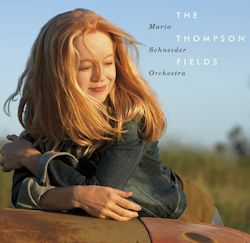
BUY NOW
AmazonUS
|
Maria Schneider Orchestra – The Thompson
Fields
Steve Wilson (alto saxophone, soprano saxophone, clarinet, flute,
alto flute); Dave Pietro ( alto saxophone, soprano saxophone, clarinet,
flute, alto flute, bass flute, piccolo); Rich Perry (tenor saxophone);
Donny McCaslin (tenor saxophone, clarinet, flute); Scott Robinson:
(baritone saxophone, bass clarinet, alto clarinet, clarinet); Tony
Kadleck (trumpet, fluegelhorn); Greg Gisbert (trumpet, fluegelhorn);
Augie Haas (trumpet, fluegelhorn); Mike Rodriguez (trumpet, fluegelhorn);
Keith O'Quinn (trombone); Ryan Keberle: (trombone); Marshall Gilkes:
(trombone); George Flynn: (bass trombone); Gary Versace: (accordion);
Lage Lund (guitar); Frank Kimbrough (piano); Rogerio Boccato (percussion
(8)); Clarence Penn (drums); Jay Anderson (bass).
Recorded August 2014, Avatar Studios, Room C, New York
ARTIST SHARE AS0137 [77:25]
|
Walking By Flashlight
The Monarch and the Milkweed
Arbiters of Evolution
The Thompson Fields
Home
Nimbus
A Potter’s Song
Lembrança
Surprisingly, perhaps, for so well-known a musician as Maria Schneider, her latest disc is the product of fan-funding and the result, of which I have a
promotional copy, is certainly attractive and very well produced. Whatever the byways by which it’s come to be, it reveals once more the rich tapestry of
which she is capable of spinning in an album which takes topography, and the sense of place, as its core element.
There are eight pieces, and each one is orchestrated with her accustomed subtlety of colour and texture, and graced moreover by fine solo contributions
from her estimable orchestra. Walking by Flashlight reveals its rich vistas, whilst The Monarch and the Milkweed – the inspiration here
is a butterfly – owes much to Gil Evans’ example. The richly athletic coloration, from brass and percussion down, explores a romanticist cantilena with the
trombone of Marshall Gilkes and the flugelhorn of Greg Gisbert overlapping avidly like pirouetting insects caught in a nature study.
The inspirations of the natural world are imprinted in this album; in that respect it is perhaps her most painterly disc yet. Bird cries call over the
landscape of Arbiters of Evolution graced by two more plangent solos, this time by two saxes. Rural Minnesota is her landscape and the title track
evokes its span in music of breadth but also simplicity. Harmonies are revealing but don’t overlook the deft guitar of Lage Lund. Schneider manages to
evoke vistas with a great sense of distance. The chorale that opens Home is not reminiscent of Aaron Copland but she has something of his sense of
encapsulating and codifying a sense of truly American feeling and this track summons up resilience and peace. But there is also drama in the flat
Minnesotan landscape as she reveals in Nimbus, where Steve Wilson’s alto is the strong protagonist – after his ruminative, reflective pianissimo
musings a really kicking groove ensues from the band. Gary Versace’s accordion imbues A Potter’s Song with intimacy and a chorale-sounding brass
theme vests density, as well as the allusive piano pointing.
All in all, this album salutes the soil and the songbird, the view and the vision, and it’s composed and coloured with great skill. Schneider certainly
calls on classical precedent, as indeed she does on Gil Evans’s influence, but she transmutes those influences to retain independence from those models and
create her own landscape poetry.
Jonathan Woolf
|
Error processing SSI file
|
